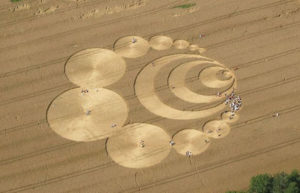Landing Instructions
Or: You Traveled a Gazillion Miles to Earth & Left Us Some Stones?

Whoa.
I'm convinced that there are aliens out there somewhere, but I'm equally convinced they haven't visited us yet.
There was a book called Chariots of the Gods? written by a hack named Erich von Däniken in 1968 that claimed the aliens visited us in ancient times and were responsible for the construction of the pyramids, Stonehenge, the stone heads of Easter Island and others.
The book was extensively rewritten by its final editor, Wilhelm Utermann, who had been a bestselling Nazi author. The book also claimed that the Old Testament, other ancient religious documents, and countless other folktales and legends were also inspired by visits from aliens in ancient times.
The key to the book's claims of aliens constructing various ancient wonders revolved around the idea that the wonders were far too technologically advanced to have been built by ancient peoples. That's just plain wrong. (I wrote about how the pyramids were built—in my first ever blog post.)
Every single one of von Däniken's claims of that nature can be rebutted fairly easily. Simply put, our ancestors were incredibly smart and innovative.
Unfortunately, von Däniken's ideas are still floating around in the form of that, ahem, television show “Ancient Aliens,” and it still relies on the ridiculous idea that our ancestors couldn't build anything on their own.
For example, crackpot theorists frequently claim that the Nazca lines are landing instructions for aliens. I’d say the aliens would’ve developed better methods for setting up landing strips. (Not to mention that the terrain around the Nazca lines would have made terrible landing strips. Landing on or near the lines would have utterly wrecked the delicate constructions.)
Also, if aliens had visited us in ancient times, do you think they could have given us better gifts than big stone monuments? You know, like plumbing, the germ theory of disease, democracy? Even just some nice farming tips?
Oh, yes, and I hope you had a happy Thanksgiving.
_________
Quotable
Oh, Yard Ramp Guy: I hear—and choose to ignore—your challenge for a holiday-relevant Thanksgiving quotation. Me, I remain blog relevant.
“I believe alien life is quite common in the universe, although intelligent life is less so. Some say it has yet to appear on planet Earth.”
— Stephen Hawking
Gorge-ous
Or: Hooked on Fishing

The one that didn't get away.
Fishing: It predates civilization…even the human race. (Birds fish, after all.)
There are plenty of ways people fish, ranging from fishing spears (which are really, really difficult to use) to nets. The best way, or at least most fun, is with a hook and a line. And it's a very old way.
The oldest fish hook in existence was carved out of shell. Fishing hook hunters (or stumble-uponers) found it in East Timor, and it dates back to as much as twenty-three THOUSAND years.
Shell was an extremely common material for ancient fish hooks. Our ancestors crafted hooks from bone, wood, horns, stone, bronze, and eventually iron. Each one of them, however, had problems of its own. Wood, for instance, floats, and that necessitates weights, or heavier bait. One common workaround was using multiple of these materials to leverage their strengths.
Fishing hooks became more common in the archaeological record around 7000 BC. Many of the early fishhooks lacked barbs, which would have made it much more difficult to fish with. In fact, one of the earliest types of fishing hook, known as a gorge hook, wasn't even curved.
The gorge hook is a small stick tapered to a point on each end. A small groove is cut around the middle, where a cord is tied. The cord is then wrapped along the length of the gorge hook, securing a piece of bait to it. When the fish grabs the bait, the cord comes unwound, which then results in the gorge hook turning sideways and lodging in the fish's throat.
This does require you to know the average length of fish in the area, though. The gorge hook has the distinction of being one of the few hooks that aren't prone to stabbing into your thumb.
Fishing with an antique-style hook is definitely a challenge. But the satisfaction you get makes it worthwhile.
_________
Quotable
Yes, Yard Ramp Guy: I believe I’ve got you this week—hook, line, and sinker:
“If people concentrated on the really important things in life, there'd be a shortage of fishing poles.”
— Doug Larson
A Not-So-Fine Mess
Faster Than Molasses in January

Spilt
On January 15, 1919, a storage tank in Boston broke, releasing 2.3 million gallons of molasses. The resulting wave of molasses rolled through the streets at about 35 miles per hour. In all, 21 people died and 150 were injured.
The actual failure can be traced to stress failures in the huge cylindrical tank. The steel was only about half as thick as it should have been and completely lacked manganese, which would have made it less brittle.
The company that owned it skipped basic safety tests, like filling the tank with water before use to check for leaks.
Compounding all of this was a rapid increase in temperature over the course of the day (almost 40 degrees), which contributed toward weakening the storage tank, resulting in the massive failure.
Rescue efforts were badly hampered by the fact that the molasses didn't clear away quickly. It remained clumped up in knee-high pools, and the search for victims took more than four days.
Workers finally used a fireboat to pump salt water from the harbor over the molasses, eventually clearing it away. Cleanup workers tracked molasses all over. Much of the city was perpetually sticky for weeks and months afterward, and the molasses stained the harbor brown until the summer.
More than a century before, on October 17, 1814, a vat containing more than 162,000 gallons of porter ruptured in London, causing multiple other vats in the same building to collapse as well. All told, almost 388,000 gallons of beer were released into the streets.
Only eight people died, due to the much smaller quantity of fluid than the Boston molasses disaster, less-crowded streets, and the lower viscosity of beer compared to molasses.
The torrent of beer demolished two houses, severely damaged a nearby pub, and flooded a nearby wake.
Otherwise, quite a few people sustained injuries when they ran outside to collect beer, making sure it didn't go to waste.
_________
Quotable
Oh, Yard Ramp Guy: my blog-relevant quotations continue…
“Welcome those big, sticky, complicated problems. In them are your most powerful opportunities.”
— Ralph Marston
That Sinking Feeling
Shipwreck Hunting

Yikes . . .
We have three million shipwrecks littering the ocean floor. We've found perhaps one percent of them. And of those shipwrecks we've found, we've sent divers to survey maybe 10 percent of them.
Why have we found and visited so few?
First off, there's not much of a budget or incentive. Only a small number of shipwrecks contain sunken treasure. (Bummer, as my grandkids say.) Of course, that “small number” contains an estimated $60 billion in treasure.
The main reason to look for sunken ships is for the purpose of avoiding collisions. Even if there was more of a budget, the ocean is HUGE. At maximum, we've explored 5-10% of the ocean floor. While we have a good idea about the general geology and geography of the ocean floor, our knowledge of the smaller details is surprisingly sparse.
The good news for shipwreck hunters is that the vast majority of shipwrecks are near the coast. Countless ships have sunk while entering dangerous harbors. For example, Oregon's Columbia River is guarded by the dangerous Columbia River Bar, which has sunk at least 2,000 ships since 1792. The high danger level is largely due to the fact that the Columbia doesn't have a river delta—it just pours straight into the ocean.
This is, incidentally, also the reason there isn't an abyssal trench off the Pacific Northwest Coast: The Columbia fills it with sediment. Of course, it also has buried many of the shipwrecks within it. Similar threats around the world are responsible for a huge number of the shipwrecks throughout history.
One of the main strategies for future oceanic exploration is the construction of robotic mapping vehicles, an initiative that’s being funded with competitions similar to the Ansari X Prize.
Still, I can't imagine we'll ever find even half of the shipwrecks on the ocean floor, which is much, much more massive—and much less hospitable—than all the land on earth.
_________
Quotable
Oh, Yard Ramp Guy: my quote selection this week is absolutely titanic...





